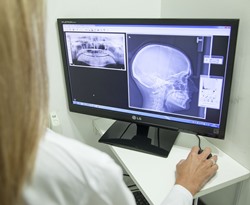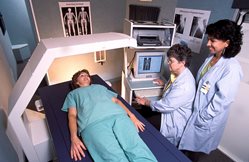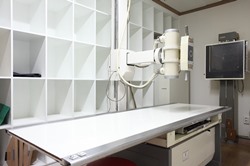How to Select the Best X Ray Tech Program near Hartford South Dakota
 So you have decided to enroll in an X-ray tech school near Hartford SD so you can train to be a radiologic technologist. But now that you have chosen to enter the rewarding field of healthcare, just how do you undertake picking the right school and program to ensure that you will obtain the proper training to become a skilled professional? And because the majority of states do require that radiology techs become licensed, based on where you ultimately work you may need preparation to pass a licensing exam. So it’s essential that you assess each of the X-ray technician schools you are looking at in order to compare each program. A number of students begin by searching for colleges or technical schools that are within driving distance of their residences. Next, they check tuition and frequently gravitate toward the lowest cost. But while expense and location must be taken into consideration, there are other significant qualifiers also. For instance, you must find out whether or not the radiology tech schools are accredited, or if they sponsor internship programs. These inquiries and others you should ask the X-ray Tech schools you are evaluating are presented later in this article. But first, let’s explore what a radiologic tech does and the credentials and training options that are offered.
So you have decided to enroll in an X-ray tech school near Hartford SD so you can train to be a radiologic technologist. But now that you have chosen to enter the rewarding field of healthcare, just how do you undertake picking the right school and program to ensure that you will obtain the proper training to become a skilled professional? And because the majority of states do require that radiology techs become licensed, based on where you ultimately work you may need preparation to pass a licensing exam. So it’s essential that you assess each of the X-ray technician schools you are looking at in order to compare each program. A number of students begin by searching for colleges or technical schools that are within driving distance of their residences. Next, they check tuition and frequently gravitate toward the lowest cost. But while expense and location must be taken into consideration, there are other significant qualifiers also. For instance, you must find out whether or not the radiology tech schools are accredited, or if they sponsor internship programs. These inquiries and others you should ask the X-ray Tech schools you are evaluating are presented later in this article. But first, let’s explore what a radiologic tech does and the credentials and training options that are offered.
X-Ray Technician Occupation Summary in Hartford SD
 There are a number of professional titles for x-ray techs (technicians or technologists). They may also be called radiologic technologists, radiologic technicians, radiology technicians or radiographers. Regardless of the name, they all have the same major job function, which is to use imaging machines to internally visualize patients for the purpose of diagnosis and treatment. Some radiologic technologists might also administer radiation therapy for treating cancer. Many opt to perform as generalists, while others may choose a specialization, for instance mammography. They can work in Hartford SD clinics, hospitals, private practices or outpatient diagnostic imaging centers. The imaging technologies that an X-Ray technician may utilize include:
There are a number of professional titles for x-ray techs (technicians or technologists). They may also be called radiologic technologists, radiologic technicians, radiology technicians or radiographers. Regardless of the name, they all have the same major job function, which is to use imaging machines to internally visualize patients for the purpose of diagnosis and treatment. Some radiologic technologists might also administer radiation therapy for treating cancer. Many opt to perform as generalists, while others may choose a specialization, for instance mammography. They can work in Hartford SD clinics, hospitals, private practices or outpatient diagnostic imaging centers. The imaging technologies that an X-Ray technician may utilize include:
- Traditional and specialized X-Rays
- Computerized tomography (CT) or “CAT” scans
- Magnetic resonance imaging (MRI)
- Sonography or ultrasound
- Fluoroscopy
Radiographers must maintain their equipment and frequently evaluate its functionality and safety. They are also required to keep in-depth records of each of their diagnostic procedures. As medical practitioners, they are held to a high professional standard and code of conduct.
Click Here For Free Information on X-Ray Tech Schools Near You!
Radiology Tech Degrees Available near Hartford SD
 The primary prerequisite for enrolling in a radiology tech college is to have earned a high school diploma or GED. Radiologic technologist pupils have the choice to earn either an Associate or a Bachelor’s Degree. An Associate Degree, which is the most common among techs, usually takes 18 months to two years to complete based upon the program and course load. A Bachelor’s Degree will take more time at as much as 4 years to finish and is more extensive in nature. The majority of students opt for a degree major in Radiography, but there are additional related majors that are acceptable as well. One thing to bear in mind is that radiographer colleges have a clinical training or lab component as a component of their course of study. It can frequently be fulfilled by taking part in an externship program which many colleges sponsor through local hospitals and clinics in Hartford SD or their area. After you have graduated from one of the degree programs, you will need to abide by any certification or licensing mandates in South Dakota or the state you will be practicing in as applicable.
The primary prerequisite for enrolling in a radiology tech college is to have earned a high school diploma or GED. Radiologic technologist pupils have the choice to earn either an Associate or a Bachelor’s Degree. An Associate Degree, which is the most common among techs, usually takes 18 months to two years to complete based upon the program and course load. A Bachelor’s Degree will take more time at as much as 4 years to finish and is more extensive in nature. The majority of students opt for a degree major in Radiography, but there are additional related majors that are acceptable as well. One thing to bear in mind is that radiographer colleges have a clinical training or lab component as a component of their course of study. It can frequently be fulfilled by taking part in an externship program which many colleges sponsor through local hospitals and clinics in Hartford SD or their area. After you have graduated from one of the degree programs, you will need to abide by any certification or licensing mandates in South Dakota or the state you will be practicing in as applicable.
Radiologic Technologist Licensing and Certification
After you have graduated from an Radiologist program, depending on the state where you will be practicing you might have to be licensed. The majority of states do mandate licensing, and their prerequisites differ so get in touch with your state. Presently, all states that do require licensure will accept The American Registry of Radiologic Technologists (ARRT) certification exam for the purpose of licensing, but a number approve additional options for testing as well. A number of states also require certification as a component of the licensing process, otherwise it is optional. Having said that, numerous Hartford area employers favor hiring radiology techs that are certified so it could improve your career options in and around Hartford SD to become certified. ARRT’s certification program involves graduation from an approved program in addition to a passing score on their comprehensive examination. ARRT also calls for re-certification every two years, which can be met with 24 credits of continuing education, or by passing an examination.
Online X-Ray Technician Schools
 As a component of any degree program, x-ray tech schools will have practical or lab training included in their curriculum. This is no different for online degree schools. So although you can still obtain your online degree, a large amount of the training will be completed either in a college lab or in an externship off campus. Practical training is often performed in Hartford SD family practices, medical clinics or hospitals in sponsorship with the schools. However the online section of the training may be attended in the comfort of your Hartford residence. Students who continue working while obtaining their degree often find that the online style of learning is much more convenient with their active schedules. Plus online programs are generally more affordable than conventional options. Along with lower tuition, expenditures for commuting and study materials may be decreased also. But just confirm that the online school you select is accredited (more on the advantages of accreditation later). So if you are disciplined enough to learn with this less formalized style of training, then online classes may be the right option for you.
As a component of any degree program, x-ray tech schools will have practical or lab training included in their curriculum. This is no different for online degree schools. So although you can still obtain your online degree, a large amount of the training will be completed either in a college lab or in an externship off campus. Practical training is often performed in Hartford SD family practices, medical clinics or hospitals in sponsorship with the schools. However the online section of the training may be attended in the comfort of your Hartford residence. Students who continue working while obtaining their degree often find that the online style of learning is much more convenient with their active schedules. Plus online programs are generally more affordable than conventional options. Along with lower tuition, expenditures for commuting and study materials may be decreased also. But just confirm that the online school you select is accredited (more on the advantages of accreditation later). So if you are disciplined enough to learn with this less formalized style of training, then online classes may be the right option for you.
What to Ask Radiology Tech Schools
As soon as you have decided on the type of degree that you would like to earn, you can begin the process of finding and evaluating x-ray tech schools near Hartford SD. You will also have to determine if you prefer to attend classes online or travel to a local campus. If you opt for the latter, then of course the location of the college will be important. The cost of tuition and supplementary expenses will be a material variable as well. But in addition to cost and location, what else should you look at when evaluating schools? Well, you need to find out if the schools are accredited, and if they sponsor externship or internship programs. To help you uncover some of these essential details before you make your selection, we have assembled a list of questions that you must ask the programs you are looking at.
Are the X-Ray Technician Schools Accredited? Most radiology technician colleges have received some form of accreditation, whether regional or national. Nevertheless, it’s still crucial to make sure that the program and school are accredited. Among the most highly respected accrediting organizations in the field of radiology is the Joint Review Committee on Education in Radiologic Technology (JRCERT). Programs obtaining accreditation from the JRCERT have gone through an extensive evaluation of their instructors and course materials. If the college is online it can also receive accreditation from the Distance Education and Training Council, which targets distance or online learning. All accrediting organizations should be acknowledged by the U.S. Department of Education or the Council on Higher Education Accreditation. In addition to guaranteeing a superior education, accreditation will also help in getting financial aid and student loans, which are often not offered for non-accredited programs. Accreditation can also be a pre-requisite for certification and licensing as required. And numerous Hartford SD health facilities will only hire graduates of an accredited college for entry-level openings.
Are Internship Programs Offered? Inquire if the radiology tech programs you are interested in have relationships with area clinics or hospitals for internship programs. Internships are not only an excellent way to obtain hands on experience in a clinical environment, they are additionally a way to satisfy the clinical training requirement for most programs. As a secondary benefit, they can assist students and graduates form professional relationships in the Hartford SD healthcare community and help with obtaining employment.
Is Job Placement Help provided? You will probably want to hit the ground running after graduating, but getting that initial job in Hartford SD in a new profession can be difficult without help. Ask if the radiographer schools you are reviewing have job assistance programs and what their success rates are. High and rapid placement rates are an excellent indication that the schools have large networks and good relationships with South Dakota healthcare employers. It also corroborates that their students are highly regarded and in demand.
Where is the Program Located? For a lot of students, the school they select will need to be within commuting distance of their Hartford SD residence. Students who have decided to attend classes online naturally will not have to trouble themselves with the location of the campus. However, the availability of local internships will be of concern. One thing to consider is that if you decide to enroll in a school that is out of state or even out of your local area, you may be required to pay a higher tuition. State colleges typically charge higher tuitions for out of state residents. And community colleges frequently charge a higher tuition for those students that live outside of their districts.
How Big are the Classes ? Unless you are the sort of student that prefers to sit far in the back of the classroom or hide in the crowd, you will likely prefer a small class size. Smaller classes enable more individual participation and one-on-one instruction. Ask the Hartford SD schools you are looking at what the average teacher to student ratio is for their classes. If practical you may want to sit in on one or more classes before making your final decision. This will also give you a chance to converse with several of the instructors and students to get their opinions regarding the xray technician program as well.
Can the College Accommodate your Schedule? And finally you must confirm that the xray tech school you finally choose can provide the class schedule you need. This is particularly important if you choose to continue working while attending school. If you need to schedule evening or weekend classes in the Hartford SD area, check that they are available. If you can only attend part-time, find out if that is an alternative and how many courses or credit hours you would need to carry. Also, ask what the procedure is for making up any classes that you might miss due to work, illness or family obligations.
Requirements for Night Radiologic Technologist Schools Hartford SD
 Selecting the best x-ray technician degree program is a crucial first step toward starting a fulfilling new career furnishing diagnostic medical services to patients. The ideal radiologic technologist must be in good physical condition. Radiology techs typically stand for the greater part of the working day and move and at times lift the patient to obtain the proper image. Candidates must also demonstrate an ability to pay strict attention to detail and to comply with the safety guidelines designed to protect both the patient and the medical team. X-Ray technicians work very closely with patients, other technicians as well as the doctors and radiologists. Possessing social skills is a necessity in order to have a productive work environment and furnish the best possible patient care. You originally came to this website due to an interest in Requirements for Night Radiologic Technologist Schools and wanting more information on the topic How to Enroll in Evening X Ray Technician Courses. However, as we have discussed in this report, there are several questions that you need to ask each college you are reviewing before making your final decision. This is equally true whether you enroll in an online school or drive to classes on-campus. By asking the right questions you can analyze and compare each school so you can focus your choices and make your decision. And with the appropriate education and your dedication to succeed, you can realize your goal to practice as a radiologic technologist in Hartford SD.
Selecting the best x-ray technician degree program is a crucial first step toward starting a fulfilling new career furnishing diagnostic medical services to patients. The ideal radiologic technologist must be in good physical condition. Radiology techs typically stand for the greater part of the working day and move and at times lift the patient to obtain the proper image. Candidates must also demonstrate an ability to pay strict attention to detail and to comply with the safety guidelines designed to protect both the patient and the medical team. X-Ray technicians work very closely with patients, other technicians as well as the doctors and radiologists. Possessing social skills is a necessity in order to have a productive work environment and furnish the best possible patient care. You originally came to this website due to an interest in Requirements for Night Radiologic Technologist Schools and wanting more information on the topic How to Enroll in Evening X Ray Technician Courses. However, as we have discussed in this report, there are several questions that you need to ask each college you are reviewing before making your final decision. This is equally true whether you enroll in an online school or drive to classes on-campus. By asking the right questions you can analyze and compare each school so you can focus your choices and make your decision. And with the appropriate education and your dedication to succeed, you can realize your goal to practice as a radiologic technologist in Hartford SD.
Other South Dakota Diagnostic Locations
Hartford, South Dakota
Hartford is a city in Minnehaha County, South Dakota, United States. A suburb of Sioux Falls, Hartford lies a few miles northwest of the city. The population was estimated to be 3,025 in July 2015, up from 2,534 at the 2010 census.
As of the census[3] of 2010, there were 2,534 people, 913 households, and 684 families residing in the city. The population density was 1,116.3 inhabitants per square mile (431.0/km2). There were 939 housing units at an average density of 413.7 per square mile (159.7/km2). The racial makeup of the city was 96.5% White, 0.6% African American, 1.2% Native American, 0.2% Asian, 0.1% from other races, and 1.4% from two or more races. Hispanic or Latino of any race were 0.6% of the population.
There were 913 households of which 45.3% had children under the age of 18 living with them, 62.2% were married couples living together, 9.4% had a female householder with no husband present, 3.3% had a male householder with no wife present, and 25.1% were non-families. 20.0% of all households were made up of individuals and 7.8% had someone living alone who was 65 years of age or older. The average household size was 2.78 and the average family size was 3.23.
